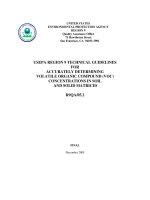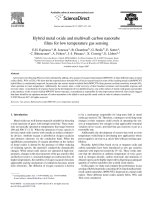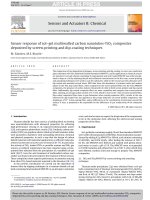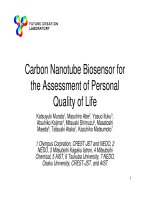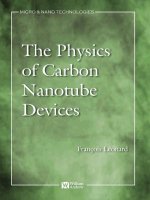- Trang chủ >>
- Khoa Học Tự Nhiên >>
- Vật lý
carbon nanotube reinforced composites. metal and ceramic matrices, 2009, p.243
Bạn đang xem bản rút gọn của tài liệu. Xem và tải ngay bản đầy đủ của tài liệu tại đây (6.81 MB, 243 trang )
Sie Chin Tjong
Carbon Nanotube Reinforced
Composites
Related Titles
Hierold, C. (ed.)
Carbon Nanotube Devices
Properties, Modeling, Integration and Applications
2008
ISBN: 978-3-527-31720-2
Haley, M. M., Tykwinski, R. R. (eds.)
Carbon-Rich Compounds
From Molecules to Materials
2006
ISBN: 978-3-527-31224-5
Reich, S., Thomsen, C., Maultzsch, J.
Carbon Nanotubes
Basic Concepts and Physical Properties
2004
ISBN: 978-3-527-40386-8
Roth, S., Carroll, D.
One-Dimensional Metals
Conjugated Polymers, Organic Crystals, Carbon Nanotubes
2004
ISBN: 978-3-527-30749-4
Sie Chin Tjong
Carbon Nanotube Reinforced
Composites
Metal and Ceramic Matrices
The Author
Prof. Sie Chin Tjong
City University of Hong Kong
Department of Physics and Materials Science
Hongkong, PR China
All books published by Wiley-VCH are carefully
produced. Nevertheless, authors, editors, and
publisher do not warrant the information contained
in these books, including this book, to be free of
errors. Readers are advised to keep in mind that
statements, data, illustrations, procedural details or
other items may inadvertently be inaccurate.
Library of Congress Card No.: applied for
British Library Cataloguing-in-Publication Data
A catalogue record for this book is available from the
British Library.
Bibliographic information published by
the Deutsche Nationalbibliothek
Die Deutsche Nationalbibliothek lists this
publication in the Deutsche Nationalbibliografie;
detailed bibliographic data are available on the
Internet at .
# 2009 WILEY-VCH Verlag GmbH & Co. KGaA,
Weinheim
All rights reserved (including those of translation into
other languages). No part of this book may be
reproduced in any form – by photoprinting,
microfilm, or any other means – nor transmitted or
translated into a machine language without written
permission from the publishers. Registered names,
trademarks, etc. used in this book, even when not
specifically marked as such, are not to be considered
unprotected by law.
Cover Design Spieszdesign, Neu-Ulm, Germany
Typesetting Thomson Digital, Noida, India
Printing Strauss Gmbh, Mörlenbach
Binding Litges & Dopf GmbH, Heppenheim
Printed in the Federal Republic of Germany
Printed on acid-free paper
ISBN: 978-3-527-40892-4
Contents
Preface IX
List of Abbreviations XI
1 Introduction 1
1.1 Background 1
1.2 Types of Carbon Nanotubes 2
1.3 Synthesis of Carbon Nanotubes 5
1.3.1 Electric Arc Discharge 5
1.3.2 Laser Ablation 7
1.3.3 Chemical Vapor Deposition 9
1.3.3.1 Thermal CVD 11
1.3.3.2 Plasma-enhanced CVD 14
1.3.3.3 Laser assisted CVD 14
1.3.3.4 Vapor Phase Growth 14
1.3.3.5 Carbon Monoxide Disproportionation 16
1.3.4 Patent Processes 17
1.4 Purification of Carbon Nanotubes 18
1.4.1 Purification Processes 18
1.4.2 Materials Characterization 20
1.5 Mechanical Properties of Carbon Nanotubes 25
1.5.1 Theoretical Modeling 25
1.5.2 Direct Measurement 26
1.6 Physical Properties of Carbon Nanotubes 29
1.6.1 Thermal Conductivity 29
1.6.2 Electrical Behavior 30
1.7 Potential and Current Challenges 32
References 33
2 Carbon Nanotube–Metal Nanocomposites 43
2.1 Overview 43
2.2 Importance of Metal-Matrix Nanocomposites 45
V
2.3 Preparation of Metal-CNT Nanocomposites 46
2.4 Aluminum-Based Nanocomposites 47
2.4.1 Spray Forming 47
2.4.2 Powder Metallurgy Processing 51
2.4.3 Controlled Growth of Nanocomposites 57
2.4.4 Severe Plastic Deformation 57
2.5 Magnesium-Based Nanocomposites 61
2.5.1 The Liquid Metallurgy Route 61
2.5.1.1 Compocasting 61
2.5.1.2 Disintegrated Melt Deposition 61
2.5.2 Powder Metallurgy Processing 62
2.5.3 Friction Stir Processing 64
2.6 Titanium-Based Nanocomposites 64
2.7 Copper-Based Nanocomposites 65
2.7.1 Liquid Infiltration 66
2.7.2 Mechanical Alloying 66
2.7.3 Molecular Level Mixing 68
2.7.4 Electrodeposition 71
2.7.5 Patent Process 72
2.8 Transition Metal-Based Nanocomposites 73
2.8.1 Ni-Based Nanocomposites 73
2.8.2 Co-Based Nanocomposites 76
2.8.3 Fe-Based Nanocomposites 77
References 80
3 Physical Properties of Carbon Nanotube–Metal Nanocomposites 89
3.1 Background 89
3.1.1 Thermal Response of Metal-Matrix Microcomposites 91
3.2 Thermal Behavior of Metal-CNT Nanocomposites 93
3.2.1 Aluminum-Based Nanocomposites 93
3.2.2 Tin-Based Nanosolder 95
3.3 Electrical Behavior of Metal-CNT Nanocomposites 98
References 100
4 Mechanical Characteristics of Carbon Nanotube–Metal
Nanocomposites 103
4.1 Strengthening Mechanism 103
4.2 Tensile Deformation Behavior 106
4.2.1 Aluminum-Based Nanocomposites 106
4.2.2 Magnesium-Based Nanocomposites 110
4.2.3 Copper-Based Nanocomposites 112
4.2.4 Nickel-Based Nanocomposites 116
4.3 Comparison with Nanoparticle-Reinforced Metals 117
4.4 Wear 119
References 127
VI Contents
5 Carbon Nanotube–Ceramic Nanocomposites 131
5.1 Overview 131
5.2 Importance of Ceramic-Matrix Nanocomposites 133
5.3 Preparation of Ceramic-CNT Nanocomposites 136
5.4 Oxide-Based Nanocomposites 138
5.4.1 Alumina Matrix 138
5.4.1.1 Hot Pressing/Extrusion 138
5.4.1.2 Spark Plasma Sintering 142
5.4.1.3 Plasma Spraying 147
5.4.1.4 Template Synthesis 149
5.4.2 Silica Matrix 150
5.4.3 Titania Matrix 155
5.4.4 Zirconia Matrix 156
5.5 Carbide-Based Nanocomposites 157
5.5.1 Silicon Carbide Matrix 157
5.6 Nitride-Based Nanocomposites 160
5.6.1 Silicon Nitride Matrix 160
References 161
6 Physical Properties of Carbon Nanotube–Ceramic
Nanocomposites 169
6.1 Background 169
6.2 Electrical Behavior 171
6.3 Percolation Concentration 172
6.4 Electromagnetic Interference Shielding 177
6.5 Thermal Behavior 179
References 182
7 Mechanical Properties of Carbon Nanotube–Ceramic
Nanocomposites 185
7.1 Fracture Toughness 185
7.2 Toughening and Strengthening Mechanisms 187
7.3 Oxide-Based Nanocomposites 189
7.3.1 Alumina Matrix 189
7.3.1.1 Deformation Behavior 189
7.3.2 Silica Matrix 200
7.4 Carbide-Based Nanocomposites 201
7.5 Nitride-Based Nanocomposites 205
7.6 Wear Behavior 207
References 212
8 Conclusions 215
8.1 Future Prospects 215
8.2 Potential Applications of CNT–Ceramic
Nanocomposites 217
Contents VII
8.2.1 Hydroxyapatite–CNT Nanocomposites 218
8.3 Potential Applications of CNT–Metal Nanocomposites 223
References 224
Index 227
VIII Contents
Preface
Carbon nanotubes are nanostructured carbon materials having large aspect ratios,
extremely high Youngs modulus and mechanical strength, as well as superior
electrical and thermal conductivities. Incorporation of a small amount of carbon
nanotube into metals and ceramics leads to the formation of high performance and
functional nanocomposites with enhanced mechanical and physical properties.
Considerable attention has been applied to the development and synthesis of carbon
nanotube-reinforced composites in the past decade. However, there is no published
book that deals exclusively with the fundamental issues and properties of carbon
nanotube-reinforced metals and ceramics. This book mainly focuses on the state-of-
the-art synthesis, microstructural characterization, physical and mechanical proper-
ties and application of carbon nanotube-reinforced composites. The various syn-
thetic and fabrication techniques, dispersion of carbon nanotubes in composite
matrices, morphological and interfacial behaviors are discussed in detail. Manufac-
turing of these nanocomposites for commercial applications is still in an embryonic
stage. Successful commercialization of such nanocomposites for industrial and
clinical applications requires a better understanding of the fundamental aspects.
With a better understanding of the processing–structure–property relationship,
carbon nanotube-reinforced composites with predicted and tailored physical/
mechanical properties as well as good biocompatibility can be designed and fabri-
cated. This book serves as a valuable and useful reference source for chemists,
materials scientists, physicists, chemical engineers, electronic engineers, mechan-
ical engineers and medical technologists engaged in the research and development
of carbon nanotube-reinforced metals and ceramics.
2008 S. C. Tjong,
City University of Hong Kong CEng CSci FIMMM
IX
List of Abbreviations
AAO Anodic aluminum oxide
AFM atomic force microscopy
ASTM American Society for Testing and Materials
CB carbon black
CF carbon fiber
CMC ceramic-matrix composite
CNB chevron notched beam
CNF carbon nanofiber
CNT Carbon nanotube
C
16
TAB hexacetyltrimethyl ammonium bromide
CTE coefficient of thermal expansion
CVD chemical vapor deposition
d.c. direct current
DMD disintegrated melt deposition
DMF N-dimethylformaldehyde
DSC differential scanning calorimetry
DTG differential thermogravimetry
ECAP equal channel angle pressing
ECR-MW electron cyclotron resonance microwave
EDS energy-dispersive spectroscopy
EDX energy-dispersive X-ray
EMI Electromagnetic interference
EPD electrophoretic deposition
f-SWNT funtionalized SWNT
FED field emission displays
FM fully melted
FSP Friction stir processing
FTIR Fourier-transform infrared
FWHM full-width at half-maximum
GF graphite flake
GPTMS (3-glycidoxypropyl)trimethoxysilane
HA hydroxyapatite
HCP hexagonal close-packed
XI
HIP hot isostatic pressing
HPC hydroxypropylcellulose
HPT high pressure torsion
HVOF high velocity oxyfuel spraying
IC integrated circuit
LCVD Laser assisted CVD
LEFM Linear elastic fracture mechanics
MA mechanical alloying
MEMS micro-electro-mechanical system
MMC Metal-matrix composite
MWNT Multi-walled carbon nanotubes
PAA poly(acrylic acid)
PAN polyacrylonitrile
PCA process control agent
PCB printed circuit board
PCS polycarbosilane
PDC polymer derived ceramic
PECVD Plasma-enhanced CVD
PEI polyethyleneamine
PIP polymer infiltration and pyrolysis
PLV pulsed laser vaporization
PM partially melted
PM powder metallurgy
PSF plasma spray forming
PSO polysiloxane
PSZ polysilazane
PVD physical vapor deposition
PVP-4 poly(4-vinylpyridine)
r.d. relative density
r.f. radio frequency
RBM radial breathing mode
ROM rule of mixture
RPS reinforcement particle size
SDS sodium dodecyl sulfate
SE shielding effectiveness
SENB single edge notched
SEPB single edge precracked beam
SEVNB single edge V-notched beam
SPS Spark plasma sintering
TBC thermal barrier coating
TCP tricalcium phosphate
TEM Transmission electron microscopy
TEOS silicon tetraethyl orthosilicate
TGA thermogravimetrical analysis
TIM thermal interface material
XII List of Abbreviations
TTCP tetracalcium phosphate
UV ultraviolet
UV-vis-NIR Ultraviolet-visible-near infrared
VGCF vapor grown carbon nanofiber
VIF Vickers indentation fracture
VLS vapor–liquid–solid
XRD X-ray diffraction
List of Abbreviations XIII
1
Introduction
1.1
Background
Composite materials with a ceramic or metal matrix offer significant performance
advantages over monolithic ceramics or metals. Structural ceramics exhibit high
mechanical strength, superior temperature stability and good chemical durability.
However, ceramics have low fracture toughness because of their ionic or covalent
bonding. The intrinsic brittleness of ceramics limits their applications in industrial
sectors. In this context, discontinuous fibers or whiskers are incorporated into
ceramics in order to reinforce and toughen them. Upon application of external
stress, matrix microcracking occurs followed by debonding of fibers from the matrix,
and subsequent bridging of fibers across matrix cracks. These processes contribute
to major energy dissipating events, thereby improving the fracture toughness of
ceramics. Recently, metal-matrix composites (MMCs) have become increasingly
used for applications in the automotive and aerospace industries because of their
high specific modulus, strength and thermal stability. MMCs are reinforced with
relatively large volume fractions of continuous fiber, discontinuous fibers, whiskers
or particulates. The incorporation of ceramic reinforcement into the metal matrix
generally leads to enhancement of strength and stiffness at the expense of fracture
toughness. Further enhancement in mechanical strength of composites can be
achieved by using nanostructured ceramic particles [1–4].
With tougher environmental regulations and increasing fuel costs, weight reduc-
tion in composites has become an important issue in the design of composite
materials. The need for advanced composite materials having enhanced functional
properties and performance characteristics is ever increasing in industrial sectors.
Since their discovery by Ijima in 1991 [5], carbon nanotubes (CNTs) with high aspect
ratio, large surface area, low density as well as excellent mechanical, electrical and
thermal properties have attracted scientific and technological interests globally.
These properties have inspired interest in using CNTs as reinforcing materials
for polymer-, metal- or ceramic-matrix composites to obtain light-weight structural
materials with enhanced mechanical, electrical and thermal properties [6–8].
Composite materials with at least one of their constituent phases being less than
j
1
100 nm are commonly termed nanocomposites. Remarkable improvements in the
mechanical and physical properties of polymer-, metal- and ceramic nanocomposites
can be achieved by adding very low loading levels of nanotubes. So far, extensive
studies have been conducted on the synthesis, structure and property of CNT-
reinforced polymers. The effects of CNT additions on the structure and property
of metals and ceramics have received increasing attention recently.
1.2
Types of Carbon Nanotubes
Hybridization of the carbon atomic orbital in the forms of sp, sp
2
and sp
3
produces
different structural forms or allotropes [9] (Figure 1.1). The sp-hybridization (car-
byne) corresponds to a linear chain-like arrangement of atomic orbital. Carbon in the
form of diamond exhibits a sp
3
-type tetrahedral covalent bonding. Each carbon
atom is linked to four others at the corners of a tetrahedron via covalent bonding.
This structure accounts for the extremely high hardness and density of diamond.
The bonding in graphite is sp
2
, with each atom joined to three neighbors in a trigonal
Figure 1.1 Tentative carbon allotropy diagram based on valence
bond hybridization. P/H corresponds to the ratio of pentagonal/
hexagonal rings. Reproduced with permission from [9]. Copyright
Ó (1997) Elsevier.
2
j
1 Introduction
planar arrangement to form sheets of hexagonal rings. Individual sheets are bonded
to one another by weak van der Waals forces. As a result, graphite is soft, and displays
electrical conductive and lubricating characteristics. All other carbon forms are
classified into intermediate or transitional forms in which the degree of hybridization
of carbon atoms can be expressed as sp
n
(1 < n < 3, n 6¼2). These include fullerenes,
carbon onions and carbon nanotubes [9]. Fullerene is made up of 60 carbon atoms
arranged in a spherical net with 20 hexagonal faces and 12 pentagonal faces, forming
a truncated icosahedral structure [10, 11].
Carbon nanotubes are formed by rolling graphene sheets of hexagonal carbon
rings into hollow cylinders. Single-walled carbon nanotubes (SWNT) are composed
of a single graphene cylinder with a diameter in the range of 0.4–3 nm and capped
at both ends by a hemisphere of fullerene. The length of nanotubes is in the range of
several hundred micrometers to millimeters. These characteristics make the nano-
tubes exhibit very large aspect ratios. The strong van der Waals attractions that exist
between the surfaces of SWNTs allow them to assemble into ropes in most cases.
Nanotube ropes may have a diameter of 10–20 nm and a length of 100 mm or above.
Multi-walled carbon nanotubes (MWNT) comprise 2 to 50 coaxial cylinders with
an interlayer spacing of 0.34 nm The diameter of MWNTs generally ranges from 4 to
30 nm [12]. The arrangement of concentric graphene cylinders in MWNTs is
somewhat similar to that of Russian doll. In contrast, a nanofiber consists of
stacked curved graphite layers that form cones or cups (Figure 1.2). The stacked
cone and cup structures are commonly referred to as herringbone and bamboo
nanofibers [13, 14].
Conceptually, the graphene sheets can be rolled into different structures, that is,
zig-zag, armchair and chiral. Accordingly, the nanotube structure can be described by
a chiral vector (
~
C
h
)defined by the following equation:
~
C
h
¼ n
~
a
1
þm
~
a
2
ð1:1Þ
Figure 1.2 Transmission electron micrograph of the double-layer
carbon nanofiber having a truncated cone structure (indicated by
an arrow). Reproduced with permission from [13]. Copyright Ó
(2006) Springer Verlag.
1.2 Types of Carbon Nanotubes
j
3
where
~
a
1
and
~
a
2
are unit vectors in a two-dimensional hexagonal lattice, and n and m
are integers. Thus, the structure of any nanotube can be expressed by the two integers
n, m and chiral angle, q (Figure 1.3). When n ¼m and q ¼30
, an armchair structure
is produced. Zig-zag nanotubes can be formed when m or n ¼0 and q ¼0
while
chiral nanotubes are formed for any other values of n and m, having q between 0
and
30
[15]. Mathematically, the nanotube diameter can be written as [16]:
d ¼
a
ffiffiffiffiffiffiffiffiffiffiffiffiffiffiffiffiffiffiffiffiffiffiffiffiffiffiffiffi
m
2
þn
2
þnm
p
p
ð1:2Þ
where a is the lattice constant in the graphene sheet, and a ¼
ffiffiffi
3
p
a
C C
; a
C C
is the
carbon–carbon distance (1.421 A
). The chiral angle, q, is given by:
tan q ¼
ffiffiffi
3
p
m
2n þm
ð1:3Þ
The electrical properties of CNTs vary from metallic to semiconducting, depending
on the chirality and diameter of the nanotubes.
The demand for inexpensive carbon-based reinforcement materials is raising
new challenges for materials scientists, chemists and physicists. In the past decade,
vapor grown carbon nanofibers (VGCFs) with diameters ranging from 50 to 200 nm
have been synthesized [17]. They are less crystalline with a stacked cone or cup
structure, while maintaining acceptable mechanical and physical properties. Com-
pared with SWNTs and MWNTs, VGCFs are available at a much lower cost because
they can be mass-produced catalytically using gaseous hydrocarbons under relatively
controlled conditions. VGCFs have large potential to override the cost barrier that has
prevented widespread application of CNTs as reinforcing materials in industries.
Figure 1.3 Schematic diagram showing chiral vector and chiral
angle in a rolled graphite sheet with a periodic hexagonal
structure. Reproduced with permission from [15]. Copyright Ó
(2001) Elsevier.
4
j
1 Introduction
1.3
Synthesis of Carbon Nanotubes
1.3.1
Electric Arc Discharge
Vaporization of carbon from solid graphite Sources into a gas phase can be achieved
by using electric arc discharge, laser and solar energy. Solar energy is rarely used as
the vaporizing Source for graphite, because it requires the use of a tailor-made
furnace to concentrate an intense solar beam for vaporizing graphite target and metal
catalysts in an inert atmosphere [18]. In contrast, the electric arc discharge technique
is the simplest and less expensive method for fabricating CNTs. In the process,
an electric (d.c.) arc is formed between two high purity graphite electrodes under the
application of a larger current in an inert atmosphere (helium or argon). The high
temperature generated by the arc causes vaporization of carbon atoms from anode
into a plasma. The carbon vapor then condenses and deposits on the cathode to form
a cylinder with a hard outer shell consisting of fused material and a softer fibrous
core containing nanotubes and other carbon nanoparticles [19]. The high reaction
temperature promotes formation of CNTs with a higher degree of crystallinity.
The growth mechanism of catalyst-free MWNTs is not exactly known. The
nucleation stage may include the formation of C
2
precursor and its subsequent
incorporation into the primary graphene structure. On the basis of transmission
electron microscopy (TEM) observations, Ijiima and coworkers proposed the open-
end growth mechanism in which carbon atoms are added at the open ends of the
tubes and the growing ends remains open during growth. The thickening of the tube
occurs by the island growth of graphite basal planes on existing tube surfaces. Tube
growth terminates when the conditions are unsuitable for the growth [20, 21].
Generally, the quality and yield of nanotubes depend on the processing conditions
employed, such as efficient cooling of the cathode, the gap between electrodes,
reaction chamber pressure, uniformity of the plasma arc, plasma temperature, and
so on [22].
Conventional electric arc discharge generally generates unstable plasma because
it induces an inhomogeneity of electric field distribution and a discontinuity of
the current flow. Lee et al. introduced the so-called plasma rotating arc discharge
techniqueinwhichthegraphiteanodeisrotatedatahighvelocityof10
4
rev min
À1
[23].
Figure 1.4 shows a schematic diagram of the apparatus. The centrifugal force
caused by the rotation generates the turbulence and accelerates the carbon vapor
perpendicular to the anode. The yield of the nanotubes can be monitored by changing
the rotation speed. Moreover, the rotation distributes the micro discharge uniformly
and generates a stable plasma with high temperatures. This enhances anode vapori-
zation, thereby increasing carbon vapor density of nanotubes significantly. Such a
technique may offer the possibility of producing nanotubes on the large scale.
Another mass production route of MWNTs can be made possible by generating
electric arc discharges in liquid nitrogen [24], as shown in Figure 1.5. Liquid nitrogen
prevents the electrode from contamination during arc discharge. The content of
1.3 Synthesis of Carbon Nanotubes
j
5
Figure 1.5 (a) Schematic drawing of the arc discharge apparatus
and (b) side image of the MWNTs rich material deposited on the
cathode. Reproduced with permission from [24]. Copyright Ó
(2003) Springer Verlag.
Figure 1.4 Schematic diagram of plasma rotating electrode
process system.Reproduced withpermission from [23].Copyright
Ó (2003) Elsevier.
6
j
1 Introduction
MWNTs can be as high as 70% of the reaction product. Auger electron spectroscopic
analysis reveals that nitrogen is not incorporated in the MWNTs. This technique is
considered an economical route for large scale synthesis of high crystalline MWNTs
as liquid nitrogen replaces expensive inert gas and cooling system for the cathode.
It is worth noting that SWNTs can only be synthesized through the arc discharge
process in the presence of metal catalysts. Typical catalysts include transition metals,
for example, Fe, Co and Ni, rare earths such as Yand Gd, and platinum group metals
such as Rh, Ru and Pt [25–32]. In this respect, the graphite anode is doped with such
metal catalysts. The synthesized nanotubes generally possess an average diameter
of 1–2 nm and tangle together to form bundles in the soot, web and string-like
structures. The as-grown SWNTs exhibitahighdegreeofcrystallinity as a result of the
high temperature of the arc plasma [30]. However, SWNTs contain a lot of metal
catalyst and amorphous carbon, and must be purified to remove them. The yield of
SWNTs produced from electric arc discharge is relatively low. The diameter and yield
of SWNTs can be controlled by using a mixed gaseous atmosphere such as inert–inert
or inert–hydrogen mixture [29, 30], and a mixture of metal catalyst particles [28, 32].
1.3.2
Laser Ablation
Laser ablation involves the generation of carbon vapor species from graphite target
using high energy laser beams followed by the condensation of such species. The
distinct advantages of laser ablation include ease of operation and production of
high quality product, because it allows better control over processing parameters.
The disadvantages are high cost of the laser Source and low yield of nanotubes
produced.
Laser beams are coherent and intense with the capability of attaining very fast rates
of vaporization of target materials. In the process, graphite target is placed inside a
quartz tube surrounded by a furnace operated at 1200
C under an inert atmosphere.
The target is irradiated with a laser beam, forming hot carbon vapor species (e.g. C
3
,
C
2
and C). These species are swept by the flowing gas from the high-temperature
zone to a conical copper collector located at the exit end of the furnace [33, 34]. Pulsed
laser beam with wavelengths in infrared and visible (CO
2
, Nd:YAG) or ultravioletUV
(excimer) range can be used to vaporize a graphite target. This is commonly referred
to as pulsed laser vaporization (PLV) technique [35–40]. Moreover, CO
2
and
Nd:YAG lasers operated in continuous wave mode have been also reported to
produce nanotubes [41–43].
SWNTs can also be produced by laser ablation but require metal catalysts as in the
case of electric arc discharge. Figure 1.6 shows a TEM image of deposits formed by
the laser (XeCl excimer) ablation of a graphite target containing 1.2% Ni and
1.2% Co [42]. Bimetal catalysts are believed to synthesize SWNTs more effectively
than monometal catalysts [33, 36]. From Figure 1.6,SWNTs having a narrow diameter
distribution (average diameter of about 1.5 nm) tend to tangle with each other to
form bundles or ropes with a thickness of about 20 nm. Their surfaces are coated with
amorphous carbon. Metal nanoparticles catalysts with the size of few to 10 nm can be
1.3 Synthesis of Carbon Nanotubes
j
7
readily seen in the micrograph. The diameter and yield of SWNTs are strongly
dependent on processing parameters such as furnace temperature, chamber pres-
sure, laser properties (energy, wavelength, pulse duration and repetition rate) and
composition of target material. The diameter of SWNTs produced by pulsed Nd:YAG
laser can be tuned to smaller sizes by reducing the furnace temperature from 1200
C
down to a threshold temperature of 850
C [35]. Using UV laser irradiation, SWNTs
can be synthesized at a lower furnace temperature of 550
C, which is much lower
than the threshold temperature of 850
C by using Nd:YAG laser [37]. Recently,
Elkund et al. employed ultrafast (subpicosecond) laser pulses for large-scale synthesis
of SWNTs at a rate of $1.5 g h
À1
[44].
To achieve controlled growth of the SWNTs, a fundamental understanding of their
growth mechanism is of particular importance. The basic growth mechanism of
SWNTs synthesized by physical vapor depositionPVD techniques is still poorly
understood. The vapor– liquid –solid (VLS) mechanism is widely used to describe
the catalytic formation of nanotubes via PVD [44, 45] and chemical vapor deposition
(CVD) techniques [46, 47]. This model was originally proposed by Wagner and Willis
to explain the formation of Si whiskers in 1964 [48]. The whiskers were grown by
heating a Si substrate containing Au metal particles in a mixture of SiCl
4
and H
2
atmosphere. An Au–Si liquid droplet was formed on the surface of the Si substrate,
acting as a preferred sink for arriving Si atoms. With continued incorporation of
silicon atoms into the liquid droplets, the liquid droplet became saturated. Once the
liquid droplet was saturated, growth occurred at the solid– liquid interface by
precipitation of Si from the droplet. Wu and Yang [49] then observed direct formation
Figure 1.6 Transmission electron micrograph of a weblike
deposit formed by laser ablation of a graphite target containing
1.2% Ni and 1.2%Co. The metal catalysts appeared as dark spots
in the micrograph. Reproduced with permission from [40].
Copyright Ó (2007) Elsevier.
8
j
1 Introduction
of Ge nanowire from an Au–Ge liquid droplet using in situ TEM (Figure 1.7).
Au nanoclusters and carbon-coated Ge microparticles were dispersed on TEM grids,
followed by in situ heating up to 900
C. Au nanoclustes remain in the solid state up to
900
C in the absence of Ge vapor condensation. With increasing amount of Ge vapor
condensation, Ge and Au form an eutectic Au–Ge alloy. The formation and growth
of Ge nanowire is explained on the basis of VLS mechanism. Figure 1.8 shows
schematic diagrams of the nucleation and growth of Ge nanowire from the eutectic
Au–Ge liquid alloy.
1.3.3
Chemical Vapor Deposition
The CVD process involves chemical reactions of volatile gaseous reactants on a
heated sample surface, resulting in the deposition of stable solid products on
Figure 1.7 In situ TEM images recorded during
the process of nanowire growth. (a) Au
nanoclusters in solid state at 500
C; (b) alloying
initiates at 800
C, at this stage Au exists in
mostly solid state; (c) liquid Au/Ge alloy; (d) the
nucleation of Ge nanocrystal on the alloy surface;
(e) Ge nanocrystal elongates with further Ge
condensation and eventually a wire forms (f);
(g) several other examples of Ge nanowire
nucleation; (h), (i) TEM images showing two
nucleation events on single alloy droplet.
Reproduced with permission from [49].
Copyright Ó (2001) The American Chemical
Society.
1.3 Synthesis of Carbon Nanotubes
j
9
the substrate. It differs distinctly from PVD techniques that involve no chemical
reactions during deposition. CVD has found widespread industrial applications
for the deposition of thin films and coatings due to its simplicity, flexibility, and low
cost. Moreover, CVD has the ability to produce high purity ceramic, metallic and
semiconducting films at high deposition rates. CVD is a versatile and cost-effective
technique for CNTsynthesis because it enables the use of a feedstock of hydrocarbons
in solid, liquid or gas phase and a variety of substrates, and permits the growth of
nanotubes in the forms of powder, thin film or thick coating, randomly oriented or
aligned tubes. The process involves the decomposition of hydrocarbon gases over
supported metal catalysts at temperatures much lower than the arc discharge and
laser ablation. The type of CNTs produced in CVD depends on the synthesis
temperatures employed. MWNTs are generally synthesized at lower temperatures
Figure 1.8 (a) Schematic illustration of vapor–liquid–solid
nanowire growth mechanism including three stages: (I) alloying,
(II) nucleation, and (III) axial growth. The three stages are
projected onto the conventional Au–Ge binary phase diagram
(b) to show the compositional and phase evolution during the
nanowire growthprocess. Reproduced with permissionfrom [49].
Copyright Ó (2001) The American Chemical Society.
10
j
1 Introduction

